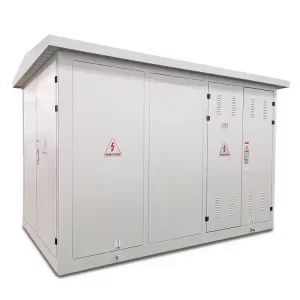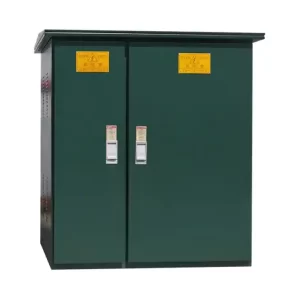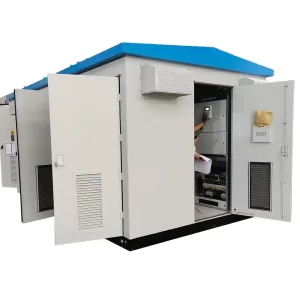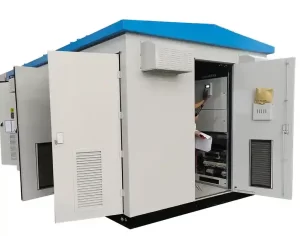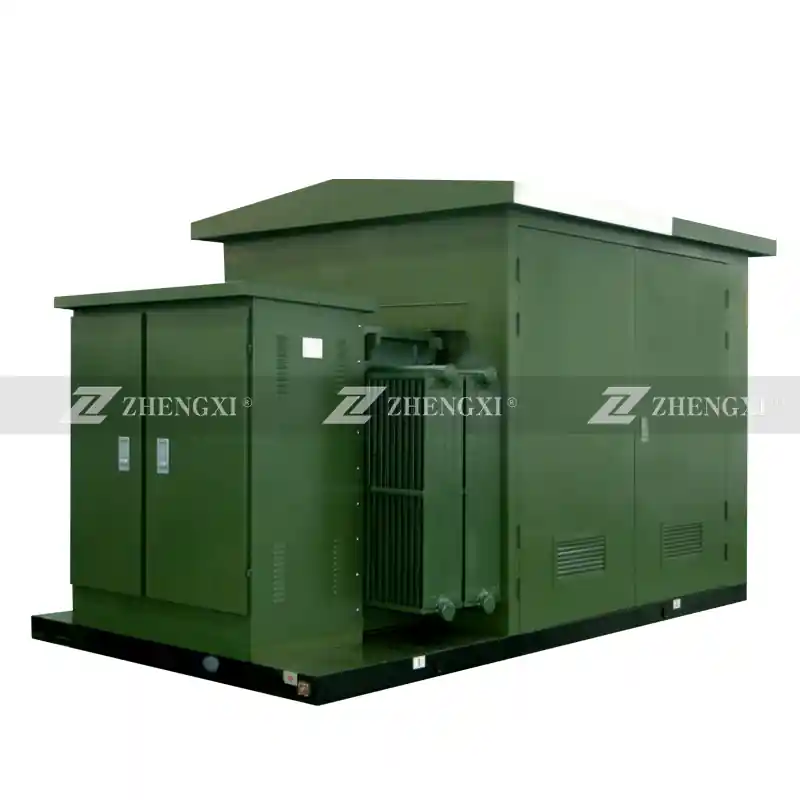
محطة فرعية مدمجة: حل توزيع الطاقة الفعال والموثوق به
A محطة فرعية مدمجة هي وحدة توزيع كهربائية متطورة وموفرة للمساحة مصممة لنقل الطاقة وتوزيعها بكفاءة في التطبيقات الصناعية والتجارية والمرافق العامة. يدمج هذا النوع من المحطات الفرعية مجموعة المفاتيح الكهربائية ذات الجهد المتوسط (MV) والمحولات ومعدات توزيع الجهد المنخفض (LV) داخل هيكل واحد مغلق، مما يضمن وجود آمنة وموثوقة وفعالة من حيث التكلفة محلول الطاقة.
على عكس المحطات الفرعية التقليدية التي تتطلب عدة حاويات منفصلة ومساحات تركيب كبيرة، توفر المحطات الفرعية المدمجة حلاً متكاملاً، مما يقلل من متطلبات المساحة وتعقيد التركيب. طبيعتها المدمجة تجعلها مثالية من أجل توزيع الطاقة في المناطق الحضرية، ومشاريع الطاقة المتجددة، والمنشآت الصناعية، والمشروعات التجارية عندما تكون الأراضي المتاحة فيها محدودة.
توفر المحطات الفرعية المدمجة مزايا كبيرة من حيث النشر السريع، والتصميم المعياري، والسلامة المعززة. نظرًا لأنها مغلقة بالكامل، فإنها توفر حماية فائقة ضد الظروف الجوية القاسية والغبار والوصول غير المصرح به، مما يضمن موثوقية تشغيلية طويلة الأجل. بالإضافة إلى ذلك، فإن تصميمها المُجمَّع مسبقًا يقلل من تكاليف العمالة في الموقع وتكاليف الإنشاءات المدنية، مما يؤدي إلى سرعة التشغيل.
صُممت المحطات الفرعية المدمجة لتتوافق مع معايير الصناعة العالمية، وهي مزودة بأنظمة حماية ومراقبة متقدمة، مما يجعلها موثوقة وفعالة للغاية. وهي تدعم نطاقاً واسعاً من تصنيفات الجهد الكهربائي، يصل عادةً إلى 33 كيلو فولتوقادرة على التعامل مع قدرات طاقة تصل إلى 2500 كيلو فولت أمبير. تدمج هذه المحطات الفرعية أيضاً ميزات مثل المراقبة عن بُعد، والتوافق مع الشبكة الذكية، والمواد الصديقة للبيئة.
ومن المزايا الرئيسية الأخرى للمحطات الفرعية المدمجة تصميم معياري ومرنمما يسمح بسهولة التوسع أو النقل مع تغير متطلبات الطاقة. يمكن تخصيصها لتلبية متطلبات المشروع المحددة، بما في ذلك مواد الضميمة المختلفة، وأنواع المحولات (المملوءة بالزيت أو من النوع الجاف)، وأنظمة التبريد. هذه القدرة على التكيف تجعلها خيارًا مفضلًا لمجموعة واسعة من التطبيقات، من مشاريع البنية التحتية إلى أنظمة الطاقة اللامركزية.
مع تنامي الطلب على توزيع الطاقة بكفاءة وموثوقية واستدامة، لا تزال المحطات الفرعية المدمجة عنصراً أساسياً في الشبكات الكهربائية الحديثة. قدرتها على دمج مجموعة المفاتيح الكهربائية والمحولات وأنظمة الحماية عالية الأداء في وحدة واحدة تعزز كفاءة الطاقة وتقلل من خسائر النقل، مما يجعلها حلاً عمليًا للأسواق المتقدمة والناشئة على حد سواء.
مزايا المحطات الفرعية المدمجة وعيوبها
مزايا المحطات الفرعية المدمجة
توفر المحطات الفرعية المدمجة العديد من المزايا مقارنةً بالمحطات الفرعية التقليدية، مما يجعلها خياراً مفضلاً للبيئات الحضرية والتطبيقات الصناعية ومشاريع الطاقة المتجددة.
| الميزة | الوصف |
|---|---|
| تصميم موفر للمساحة | يتطلب الهيكل المدمج الحد الأدنى من مساحة التركيب، وهو مثالي للمناطق الحضرية والصناعية. |
| تقليل وقت التثبيت والتكاليف | يعمل التصميم الجاهز والمُجمَّع في المصنع على تسريع عملية النشر وتقليل تكاليف العمالة. |
| ميزات السلامة المحسّنة | وحدة مغلقة بالكامل تقلل من التعرض للمخاطر الكهربائية والوصول غير المصرح به. |
| تشغيل موثوق وفعال | يضمن التصميم المحسّن توزيعاً مستقراً للطاقة بأقل وقت تعطل ممكن. |
| قابل للتخصيص حسب المتطلبات الخاصة | متوفر بتكوينات مختلفة لتتناسب مع تصنيفات الجهد الكهربائي المختلفة ومتطلبات الأحمال. |
| Easy to Transport & Relocate | Modular structure allows for easy transportation and repositioning when needed. |
| Reduced Environmental Impact | Compact footprint minimizes land use and can incorporate eco-friendly components. |
| Quick Installation & Commissioning | Factory-tested and pre-assembled units reduce on-site installation time. |
| Lower Civil Works & Site Preparation | Reduces the need for extensive civil engineering works, saving time and costs. |
| Improved Aesthetic & Urban Integration | Modern enclosures blend well with cityscapes and industrial facilities. |
| Lower Distribution Losses | Reduces transmission losses by placing transformers closer to the load centers. |
| Suitable for Remote & Space-Constrained Locations | Perfect for sites with limited land availability or off-grid applications. |
| Modular Design for Easy Expansion | Scalable solutions allow for future capacity upgrades or reconfiguration. |
| Enhanced Security & Protection | Fully enclosed structure offers better protection against vandalism and unauthorized access. |
| Advanced Monitoring & Control | Smart grid integration allows remote monitoring and fault diagnostics. |
| Reduced Transmission Losses | Strategically placed substations optimize energy efficiency. |
| Potential for Renewable Energy Integration | Easily integrates with solar farms, wind power, and battery storage systems. |
| Faster Fault Detection & Isolation | Advanced protection systems minimize downtime in case of failures. |
| Compliance with Industry Standards | Meets global safety and efficiency regulations, ensuring high reliability. |
Disadvantages of Compact Substations
Despite their advantages, compact substations also have some limitations that should be considered when planning a power distribution system.
| Disadvantage | الوصف |
|---|---|
| Limited Space for Expansion | Fixed enclosure may restrict the addition of extra components or future capacity upgrades. |
| Higher Initial Cost | Specialized design and prefabrication may have a higher upfront investment. |
| Maintenance Challenges | Compact layout may make repairs and maintenance more difficult. |
| Limited Flexibility for Configuration Changes | Pre-assembled design may not allow for major modifications after installation. |
| Specialized Equipment for Installation | May require cranes or specialized transport due to pre-assembled design. |
| Not Suitable for Large-Scale Power Distribution | Compact substations are best for localized distribution rather than high-voltage transmission. |
| Heat Dissipation Challenges | Limited space may require additional cooling systems to prevent overheating. |
| Potential Noise Levels | Compact layout may lead to increased noise levels in certain environments. |
| Reduced Accessibility for Maintenance | Enclosed design may require specialized access procedures. |
| Higher Vulnerability to Equipment Failure | Limited redundancy options may increase risks in case of faults. |
| Interconnection Challenges | May require additional compatibility checks when integrating into existing grid networks. |
| Supplier & Component Constraints | Specialized design may limit sourcing options for replacement parts. |
Compact substations offer a modern and efficient solution for power distribution in urban areas, industrial facilities, and renewable energy projects. Their advantages, including space-saving design, quick installation, and enhanced safety, make them an attractive alternative to conventional substations.
However, factors like limited expansion capability and higher initial investment should be carefully evaluated before choosing a compact substation for a project. Understanding both the benefits and limitations will help in selecting the right power distribution solution for specific application needs.
What is a compact substation?
A Compact Secondary Substation (CSS), also known as a Compact Transformer Substation (CTS) أو Packaged Substation, is a fully integrated, factory-assembled electrical distribution unit designed for safe and efficient medium voltage (MV) to low voltage (LV) power conversion. It consists of MV switchgear, a distribution transformer, LV switchgear, connections, and auxiliary equipment, all housed within a compact and weatherproof enclosure.
Unlike traditional substations that require large installation areas and multiple components, compact substations integrate all essential electrical equipment into a prefabricated unit, allowing for space-saving, rapid deployment, and easy installation. Their pre-tested and arc-tested design ensures high reliability, enhanced safety, and efficient power distribution.
Compact substations are widely used in urban power grids, industrial facilities, renewable energy projects, and infrastructure developments. They are available in various configurations to meet specific operational needs, making them a preferred choice for modern electrical networks.
What is the Rating of a Compact Substation?
A محطة فرعية مدمجة is designed to handle various power distribution requirements based on its rating, voltage class, and frequency. Below are the general specifications of a compact substation:
Specifications
| المعلمة | القيمة |
|---|---|
| Ratings | Up to 2500 kVA |
| Voltage Class | Up to 33 kV |
| التردد | 50/60 Hz |
| HT Side | RMU / VCB / Fused Isolators (up to 33 kV) |
Compact substations are available in multiple configurations to meet the specific needs of different power distribution systems. Their ratings ensure reliable and efficient power conversion in industrial, commercial, and infrastructure applications.


